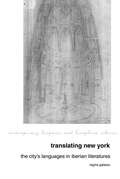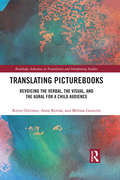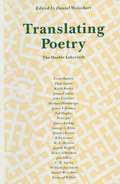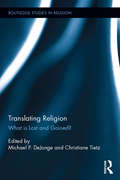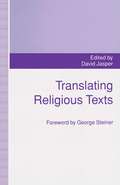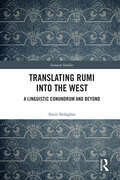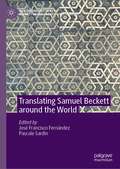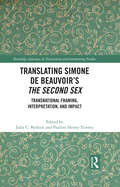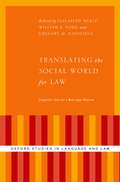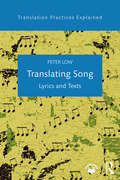- Table View
- List View
Translating National Allegories: The Case of Crime Fiction
by Alistair Rolls John West-Sooby Marie-Laure Vuaille-BarcanThis book explores the intersection of a number of academic areas of study that are all, individually, of growing importance: translation studies, crime fiction and world literature. The scholars included here are leaders in one or more of these areas. The frame of this volume is imagological; its focus is on the ways in which national allegories are constructed and deconstructed, encompassing descriptions of national characteristics as they play out at the level of the local or the individual as well as broader, political analyses. Its corpus, crime fiction, is shown to be a privileged site for writing the national narrative, and often in ways that are more complex and dynamic than is suggested by the genre’s much-cited role as vehicle for a new realism. Finally, these two areas are problematised through the lens of translation, which is a crucial player in both the development of crime fiction and the formation, rather than simply the interlingual transfer, of national allegory. In this volume national allegories, and the crime novels in which they emerge, are shown to be eminently versatile, foundationally plural texts that promote critical rewriting as opposed to sites for fixing meaning. This book was originally published as a special issue of The Translator.
Translating New York: The City's Languages in Iberian Literatures (Contemporary Hispanic and Lusophone Cultures #17)
by Regina GalassoThe cultural production of Spanish-speaking New York is closely linked to the Caribbean and to Latin America at large, but the city also plays a pivotal role in the work of a host of authors from the Iberian Peninsula, writing in Spanish, Catalan, and English. In many cases, their New York City texts have marked their careers and the history of their national literatures. Drawing from a variety of genres, Translating New York recovers cultural narratives occluded by single linguistic or national literary histories, and proposes that reading these texts through the lens of translation unveils new pathways of cultural circulation and influence. Looking beyond representations of the city's physical space, Translating New York suggests that travel to the city and contact with New York's multilingual setting ignited a heightened sensitivity towards both the verbal and non-verbal languages of the city, garnering literary achievement and aesthetic innovation. Analyzing the novels, poetry, and travel narratives of Felipe Alfau, José Moreno Villa, Julio Camba, and Josep Pla, this book uncovers an international perspective of Iberian literatures. Translating New York aims to rethink Iberian literatures through the transatlantic travels of influential writers.The pre-publication version of Translating New York was awarded the 2017 Northeast Modern Language Association Book Award for the best unpublished book-length manuscript on modern language literature.
Translating Official Documents (Translation Practices Explained)
by Roberto Mayoral AsensioOfficial translations are generally documents that serve as legally valid instruments. They include anything from certificates of birth, death or marriage through to academic transcripts or legal contracts. This field of translation is now as important as it is fraught with difficulties, for it is only in a few areas that the cultural differences are so acute and the consequences of failure so palpable. In a globalizing world, our official institutions increasingly depend on translations of official documents, but little has been done to elaborate the skills and dilemmas involved. Roberto Mayoral deals with the very practical problems of official translating. He points out the failings of traditional theories in this field and the need for revised concepts such as the virtual document, pragmatic constraints, and risk analysis. He details aspects of the social contexts, ethical norms, translation strategies, different formats, fees, legal formulas, and ways of solving the most frequent problems. Care is taken to address as wide a range of cultural contexts as possible and to stress the active role of the translator. This book is intended as a teaching text for the classroom, for self-learning, or for professionals who want to reflect on their practice. Activities and exercises are suggested for each chapter, and information is included on professional associations and societies across the globe.
Translating Official Documents (Translation Practices Explained)
by Roberto Mayoral AsensioOfficial translations are generally documents that serve as legally valid instruments. They include anything from certificates of birth, death or marriage through to academic transcripts or legal contracts. This field of translation is now as important as it is fraught with difficulties, for it is only in a few areas that the cultural differences are so acute and the consequences of failure so palpable. In a globalizing world, our official institutions increasingly depend on translations of official documents, but little has been done to elaborate the skills and dilemmas involved. Roberto Mayoral deals with the very practical problems of official translating. He points out the failings of traditional theories in this field and the need for revised concepts such as the virtual document, pragmatic constraints, and risk analysis. He details aspects of the social contexts, ethical norms, translation strategies, different formats, fees, legal formulas, and ways of solving the most frequent problems. Care is taken to address as wide a range of cultural contexts as possible and to stress the active role of the translator. This book is intended as a teaching text for the classroom, for self-learning, or for professionals who want to reflect on their practice. Activities and exercises are suggested for each chapter, and information is included on professional associations and societies across the globe.
Translating Others (Volume 1)
by Theo HermansBoth in the sheer breadth and in the detail of their coverage the essays in these two volumes challenge hegemonic thinking on the subject of translation. Engaging throughout with issues of representation in a postmodern and postcolonial world, Translating Others investigates the complex processes of projection, recognition, displacement and 'othering' effected not only by translation practices but also by translation studies as developed in the West. At the same time, the volumes document the increasing awareness the the world is peopled by others who also translate, often in ways radically different from and hitherto largely ignored by the modes of translating conceptualized in Western discourses. The languages covered in individual contributions include Arabic, Bengali, Chinese, Hindi, Irish, Italian, Japanese, Latin, Rajasthani, Somali, Swahili, Tamil, Tibetan and Turkish as well as the Europhone literatures of Africa, the tongues of medieval Europe, and some major languages of Egypt's five thousand year history. Neighbouring disciplines invoked include anthropology, semiotics, museum and folklore studies, librarianship and the history of writing systems. Contributors to Volume 1: Doris Bachmann-Medick, Cosima Bruno, Ovidi Carbonell, Martha Cheung, G. Gopinathan, Eva Hung, Alexandra Lianeri, Carol Maier, Christi Ann Marrill, Paolo Rambelli, Myriam Salama-Carr, Ubaldo Stecconi and Maria Tymoczko.
Translating Others (Volume 1)
by Theo HermansBoth in the sheer breadth and in the detail of their coverage the essays in these two volumes challenge hegemonic thinking on the subject of translation. Engaging throughout with issues of representation in a postmodern and postcolonial world, Translating Others investigates the complex processes of projection, recognition, displacement and 'othering' effected not only by translation practices but also by translation studies as developed in the West. At the same time, the volumes document the increasing awareness the the world is peopled by others who also translate, often in ways radically different from and hitherto largely ignored by the modes of translating conceptualized in Western discourses. The languages covered in individual contributions include Arabic, Bengali, Chinese, Hindi, Irish, Italian, Japanese, Latin, Rajasthani, Somali, Swahili, Tamil, Tibetan and Turkish as well as the Europhone literatures of Africa, the tongues of medieval Europe, and some major languages of Egypt's five thousand year history. Neighbouring disciplines invoked include anthropology, semiotics, museum and folklore studies, librarianship and the history of writing systems. Contributors to Volume 1: Doris Bachmann-Medick, Cosima Bruno, Ovidi Carbonell, Martha Cheung, G. Gopinathan, Eva Hung, Alexandra Lianeri, Carol Maier, Christi Ann Marrill, Paolo Rambelli, Myriam Salama-Carr, Ubaldo Stecconi and Maria Tymoczko.
Translating Others (Volume 2)
by Theo HermansBoth in the sheer breadth and in the detail of their coverage the essays in these two volumes challenge hegemonic thinking on the subject of translation. Engaging throughout with issues of representation in a postmodern and postcolonial world, Translating Others investigates the complex processes of projection, recognition, displacement and 'othering' effected not only by translation practices but also by translation studies as developed in the West. At the same time, the volumes document the increasing awareness the the world is peopled by others who also translate, often in ways radically different from and hitherto largely ignored by the modes of translating conceptualized in Western discourses. The languages covered in individual contributions include Arabic, Bengali, Chinese, Hindi, Irish, Italian, Japanese, Latin, Rajasthani, Somali, Swahili, Tamil, Tibetan and Turkish as well as the Europhone literatures of Africa, the tongues of medieval Europe, and some major languages of Egypt's five thousand year history. Neighbouring disciplines invoked include anthropology, semiotics, museum and folklore studies, librarianship and the history of writing systems. Contributors to Volume 2: Paul Bandia, Red Chan, Sukanta Chaudhuri, Annmarie Drury, Ruth Evans, Fabrizio Ferrari, Daniel Gallimore, Hephzibah Israel, John Tszpang Lai, Kenneth Liu-Szu-han, Ibrahim Muhawi, Martin Orwin, Carol O'Sullivan, Saliha Parker, Stephen Quirke and Kate Sturge.
Translating Others (Volume 2)
by Theo HermansBoth in the sheer breadth and in the detail of their coverage the essays in these two volumes challenge hegemonic thinking on the subject of translation. Engaging throughout with issues of representation in a postmodern and postcolonial world, Translating Others investigates the complex processes of projection, recognition, displacement and 'othering' effected not only by translation practices but also by translation studies as developed in the West. At the same time, the volumes document the increasing awareness the the world is peopled by others who also translate, often in ways radically different from and hitherto largely ignored by the modes of translating conceptualized in Western discourses. The languages covered in individual contributions include Arabic, Bengali, Chinese, Hindi, Irish, Italian, Japanese, Latin, Rajasthani, Somali, Swahili, Tamil, Tibetan and Turkish as well as the Europhone literatures of Africa, the tongues of medieval Europe, and some major languages of Egypt's five thousand year history. Neighbouring disciplines invoked include anthropology, semiotics, museum and folklore studies, librarianship and the history of writing systems. Contributors to Volume 2: Paul Bandia, Red Chan, Sukanta Chaudhuri, Annmarie Drury, Ruth Evans, Fabrizio Ferrari, Daniel Gallimore, Hephzibah Israel, John Tszpang Lai, Kenneth Liu-Szu-han, Ibrahim Muhawi, Martin Orwin, Carol O'Sullivan, Saliha Parker, Stephen Quirke and Kate Sturge.
Translating Picturebooks: Revoicing the Verbal, the Visual and the Aural for a Child Audience (Routledge Advances in Translation and Interpreting Studies)
by Riitta Oittinen Anne Ketola Melissa GaraviniTranslating Picturebooks examines the role of illustration in the translation process of picturebooks and how the word-image interplay inherent in the medium can have an impact both on translation practice and the reading process itself. The book draws on a wide range of picturebooks published and translated in a number of languages to demonstrate the myriad ways in which information and meaning is conveyed in the translation of multimodal material and in turn, the impact of these interactions on the readers’ experiences of these books. The volume also analyzes strategies translators employ in translating picturebooks, including issues surrounding culturally-specific references and visual and verbal gaps, and features a chapter with excerpts from translators’ diaries written during the process. Highlighting the complex dynamics at work in the translation process of picturebooks and their implications for research on translation studies and multimodal material, this book is an indispensable resource for students and researchers in translation studies, multimodality, and children’s literature.
Translating Picturebooks: Revoicing the Verbal, the Visual and the Aural for a Child Audience (Routledge Advances in Translation and Interpreting Studies)
by Riitta Oittinen Anne Ketola Melissa GaraviniTranslating Picturebooks examines the role of illustration in the translation process of picturebooks and how the word-image interplay inherent in the medium can have an impact both on translation practice and the reading process itself. The book draws on a wide range of picturebooks published and translated in a number of languages to demonstrate the myriad ways in which information and meaning is conveyed in the translation of multimodal material and in turn, the impact of these interactions on the readers’ experiences of these books. The volume also analyzes strategies translators employ in translating picturebooks, including issues surrounding culturally-specific references and visual and verbal gaps, and features a chapter with excerpts from translators’ diaries written during the process. Highlighting the complex dynamics at work in the translation process of picturebooks and their implications for research on translation studies and multimodal material, this book is an indispensable resource for students and researchers in translation studies, multimodality, and children’s literature.
Translating Poetry: The Double Labyrinth
by Daniel WeissbortThis volume, with contributions in the form of narrations, or of work sheets, by leading British and American translators, shows what happens: how problems present themselves and how they are resolved.
Translating Popular Film
by C. O'SullivanA ground-breaking study of the roles played by foreign languages in film and television and their relationship to translation. The book covers areas such as subtitling and the homogenising use of English, and asks what are the devices used to represent foreign languages on screen?
Translating Promotional and Advertising Texts
by Ira TorresiPromotional and advertising texts come in different forms and account for a considerable share of the translation market. Advertisements, company brochures, websites, tourist guides, institutional information campaigns, and even personal CVs all share a common primary purpose: that of persuading the reader to buy something, be it a product or a lifestyle, or to act in a particular way, from taking preventive measures against health risks to employing one candidate in preference to another. Consequently, their translation requires the application of techniques which, although they vary depending on the specific text type, are all aimed at preserving that persuasive purpose. This often requires in-depth cultural adaptation and, on occasion, thorough rewriting. Translating Promotional and Advertising Texts covers different areas of personal promotion, business to business promotion, institutional and business to consumer promotion, including advertising. Numerous examples from a wide variety of languages and media, taken from the author's own professional experience and from real-life observation, are provided throughout. The volume is designed for use as a coursebook for classroom practice or as a handbook for self-learning. It will be of interest to undergraduate and postgraduate students, but also freelance and in-house translators, as well as other professionals working in sales, public relations or similar departments whose responsibilities include involvement in the management of multilingual advertising and promotion activities.
Translating Promotional and Advertising Texts
by Ira TorresiPromotional and advertising texts come in different forms and account for a considerable share of the translation market. Advertisements, company brochures, websites, tourist guides, institutional information campaigns, and even personal CVs all share a common primary purpose: that of persuading the reader to buy something, be it a product or a lifestyle, or to act in a particular way, from taking preventive measures against health risks to employing one candidate in preference to another. Consequently, their translation requires the application of techniques which, although they vary depending on the specific text type, are all aimed at preserving that persuasive purpose. This often requires in-depth cultural adaptation and, on occasion, thorough rewriting. Translating Promotional and Advertising Texts covers different areas of personal promotion, business to business promotion, institutional and business to consumer promotion, including advertising. Numerous examples from a wide variety of languages and media, taken from the author's own professional experience and from real-life observation, are provided throughout. The volume is designed for use as a coursebook for classroom practice or as a handbook for self-learning. It will be of interest to undergraduate and postgraduate students, but also freelance and in-house translators, as well as other professionals working in sales, public relations or similar departments whose responsibilities include involvement in the management of multilingual advertising and promotion activities.
Translating Religion: What is Lost and Gained? (Routledge Studies in Religion)
by Michael DeJonge Christiane TietzTranslating Religion advances thinking about translation as a critical category in religious studies, combining theoretical reflection about processes of translation in religion with focused case studies that are international, interdisciplinary, and interreligious. By operating with broad conceptions of both religion and translation, this volume makes clear that processes of translation, broadly construed, are everywhere in both religious life and the study of religion; at the same time, the theory and practice of translation and the advancement of translation studies as a field has developed in the context of concerns about the possibility and propriety of translating religious texts. The nature of religions as living historical traditions depends on the translation of religion from the past into the present. Interreligious dialogue and the comparative study of religion require the translation of religion from one tradition to another. Understanding the historical diffusion of the world’s religions requires coming to terms with the success and failure of translating a religion from one cultural context into another. Contributors ask what it means to translate religion, both textually and conceptually, and how the translation of religious content might differ from the translation of other aspects of human culture. This volume proposes that questions on the nature of translation find particularly acute expression in the domains of religion, and argues that theoretical approaches from translation studies can be fruitfully brought to bear on contemporary religious studies.
Translating Religion: What is Lost and Gained? (Routledge Studies in Religion)
by Christiane Tietz Michael P. DeJongeTranslating Religion advances thinking about translation as a critical category in religious studies, combining theoretical reflection about processes of translation in religion with focused case studies that are international, interdisciplinary, and interreligious. By operating with broad conceptions of both religion and translation, this volume makes clear that processes of translation, broadly construed, are everywhere in both religious life and the study of religion; at the same time, the theory and practice of translation and the advancement of translation studies as a field has developed in the context of concerns about the possibility and propriety of translating religious texts. The nature of religions as living historical traditions depends on the translation of religion from the past into the present. Interreligious dialogue and the comparative study of religion require the translation of religion from one tradition to another. Understanding the historical diffusion of the world’s religions requires coming to terms with the success and failure of translating a religion from one cultural context into another. Contributors ask what it means to translate religion, both textually and conceptually, and how the translation of religious content might differ from the translation of other aspects of human culture. This volume proposes that questions on the nature of translation find particularly acute expression in the domains of religion, and argues that theoretical approaches from translation studies can be fruitfully brought to bear on contemporary religious studies.
Translating Religious Texts: Translation, Transgression and Interpretation
by D. Jasper George SteinerTranslating Rumi into the West: A Linguistic Conundrum and Beyond (Iranian Studies)
by Amir SedaghatFocusing on Rumi, the best-selling Persian mystical poet of the 13th century, this book investigates the reception of his work and thought in North America and Europe – and the phenomenon of ‘Rumimania’ – to elucidate the complexities of intercultural communication between the West and the Iranian and Islamic worlds. Presenting tens of examples from the original and translated texts, the book is a critical analysis of various dimensions of this reception, outlining the difficulties of translating the text but also exploring how translators of various times and languages have performed, and explaining why the quality of reception varies. Topics analysed include the linguistic and pragmatic issues of translation, comparative stylistics and poetics, and non-textual factors like the translator’s beliefs and the political and ideological aspects of translation. Using a broad theoretical framework, the author highlights the difficulties of intercultural communication from linguistic, semiotic, stylistic, poetic, ethical, and sociocultural perspectives. Ultimately, the author shares his reflections on the semiotic specificities of Rumi’s mystical discourse and the ethics of translation generally. The book will be valuable to scholars and students of Islamic philosophy, Iranian studies, and translation studies, but will appeal to anyone interested in the cultural dichotomies of the West and Islam.
Translating Rumi into the West: A Linguistic Conundrum and Beyond (Iranian Studies)
by Amir SedaghatFocusing on Rumi, the best-selling Persian mystical poet of the 13th century, this book investigates the reception of his work and thought in North America and Europe – and the phenomenon of ‘Rumimania’ – to elucidate the complexities of intercultural communication between the West and the Iranian and Islamic worlds. Presenting tens of examples from the original and translated texts, the book is a critical analysis of various dimensions of this reception, outlining the difficulties of translating the text but also exploring how translators of various times and languages have performed, and explaining why the quality of reception varies. Topics analysed include the linguistic and pragmatic issues of translation, comparative stylistics and poetics, and non-textual factors like the translator’s beliefs and the political and ideological aspects of translation. Using a broad theoretical framework, the author highlights the difficulties of intercultural communication from linguistic, semiotic, stylistic, poetic, ethical, and sociocultural perspectives. Ultimately, the author shares his reflections on the semiotic specificities of Rumi’s mystical discourse and the ethics of translation generally. The book will be valuable to scholars and students of Islamic philosophy, Iranian studies, and translation studies, but will appeal to anyone interested in the cultural dichotomies of the West and Islam.
Translating Samuel Beckett around the World (New Interpretations of Beckett in the Twenty-First Century)
by José Francisco Fernández Pascale SardinThe global reception of Samuel Beckett raises numerous questions: in which areas of the world was Beckett first translated? Why were Beckett texts sometimes slow to penetrate certain cultures? How were national literatures impacted by Beckett's oeuvre? Translating Samuel Beckett around the World brings together leading researchers in Beckett studies to discuss these questions and explore the fate of Beckett in their own societies and national languages. The current text provides ample coverage of the presence of Beckett in geographical contexts normally ignored by literary criticism, and reveals unknown aspects of the 1969 Nobel Prize winner interacting with translators of his work in a number of different countries.
Translating Simone de Beauvoir’s The Second Sex: Transnational Framing, Interpretation, and Impact (Routledge Advances in Translation and Interpreting Studies)
by Julia C. Bullock Pauline Henry-TierneyThis collection offers insights into the transnational and translingual implications of Simone de Beauvoir’s Le Deuxième Sexe (The Second Sex), a text that has served as foundational for feminisms worldwide since its publication in 1949. Little scholarly attention has been devoted to how the original French-language source text made its way into languages other than English. This is a shocking omission, given that many (but by no means all) other translations were based on the 1953 English translation by Howard M. Parshley, which has been widely criticized by Beauvoir scholars for its omissions and careless attention to its philosophical implications. This volume seeks to fill this gap in scholarship with an innovative collection of essays that interrogate the ways that Beauvoir’s essay has shifted in meaning and significance as it has travelled across the globe. This volume brings together for the first time scholars from Translation Studies, Literary Studies and Philosophical Studies, and over half of it is dedicated to non-Western European engagements with Le Deuxième Sexe (including chapters on the Chinese, Japanese, Arabic, Hungarian and Polish translations). As such, this collection will be essential to any scholar of Beauvoir’s philosophy and its contributions to feminist discourses.
Translating Simone de Beauvoir’s The Second Sex: Transnational Framing, Interpretation, and Impact (Routledge Advances in Translation and Interpreting Studies)
by Bullock Julia C.This collection offers insights into the transnational and translingual implications of Simone de Beauvoir’s Le Deuxième Sexe (The Second Sex), a text that has served as foundational for feminisms worldwide since its publication in 1949. Little scholarly attention has been devoted to how the original French-language source text made its way into languages other than English. This is a shocking omission, given that many (but by no means all) other translations were based on the 1953 English translation by Howard M. Parshley, which has been widely criticized by Beauvoir scholars for its omissions and careless attention to its philosophical implications. This volume seeks to fill this gap in scholarship with an innovative collection of essays that interrogate the ways that Beauvoir’s essay has shifted in meaning and significance as it has travelled across the globe. This volume brings together for the first time scholars from Translation Studies, Literary Studies and Philosophical Studies, and over half of it is dedicated to non-Western European engagements with Le Deuxième Sexe (including chapters on the Chinese, Japanese, Arabic, Hungarian and Polish translations). As such, this collection will be essential to any scholar of Beauvoir’s philosophy and its contributions to feminist discourses.
TRANSLATING SOCIAL WORLD FOR LAW OXSLL C: Linguistic Tools for a New Legal Realism (Oxford Studies in Language and Law)
by Elizabeth Mertz, William K. Ford, and Gregory MatoesianThis volume examines the linguistic problems that arise in efforts to translate between law and the social sciences. We usually think of "translation" as pertaining to situations involving distinct languages such as English and Swahili. But realistically, we also know that there are many kinds of English or Swahili, so that some form of translation may still be needed even between two people who both speak English-including, for example, between English speakers who are members of different professions. Law and the social sciences certainly qualify as disciplines with quite distinctive language patterns and practices, as well as different orientations and goals. In coordinated papers that are grounded in empirical research, the volume contributors use careful linguistic analysis to understand how attempts to translate between different disciplines can misfire in systematic ways. Some contributors also point the way toward more fruitful translation practices. The contributors to this volume are members of an interdisciplinary working group on Legal Translation that met for a number of years. The group includes scholars from law, philosophy, anthropology, linguistics, political science, psychology, and religious studies. The members of this group approach interdisciplinary communication as a form of "translation" between distinct disciplinary languages (or, "registers"). Although it may seem obvious that professionals in different fields speak and think differently about the world, in fact experts in law and in social science too often assume that they can communicate easily when they are speaking what appears to be the "same" language. While such experts may intellectually understand that they differ regarding their fundamental assumptions and uses of language, they may nonetheless consistently underestimate the degree to which they are actually talking past one another. This problem takes on real-life significance when one of the fields is law, where how knowledge is conveyed can affect how justice is meted out.
Translating Song: Lyrics and Texts (Translation Practices Explained)
by Peter LowThis engaging step-by-step guide prescribes effective strategies and tactics for translating a wide range of songs and other vocal music, from classical to contemporary. Focusing on best practice and with a variety of language examples, the book centres on four key themes: translating songs for a range of recipients and within different contexts (skopos theory) translating songs for reading on paper or on screens (surtitles and subtitles) "singable translations" and the Pentathlon Approach translating expressive texts. With a substantial introduction, six insightful chapters, further reading and a glossary of key terms (also available at https://www.routledge.com/9781138641792 and on the Routledge Translation Studies Portal), this lively and clear student-friendly guide is essential for students, researchers and practitioners involved in or studying the practice of translating music. This will also be an engaging read for musicians and all those interested in the study of music.
Translating Song: Lyrics and Texts (Translation Practices Explained)
by Peter LowThis engaging step-by-step guide prescribes effective strategies and tactics for translating a wide range of songs and other vocal music, from classical to contemporary. Focusing on best practice and with a variety of language examples, the book centres on four key themes: translating songs for a range of recipients and within different contexts (skopos theory) translating songs for reading on paper or on screens (surtitles and subtitles) "singable translations" and the Pentathlon Approach translating expressive texts. With a substantial introduction, six insightful chapters, further reading and a glossary of key terms (also available at https://www.routledge.com/9781138641792 and on the Routledge Translation Studies Portal), this lively and clear student-friendly guide is essential for students, researchers and practitioners involved in or studying the practice of translating music. This will also be an engaging read for musicians and all those interested in the study of music.

